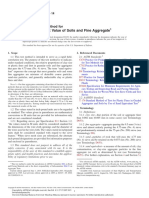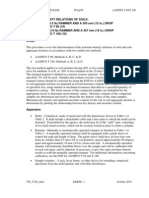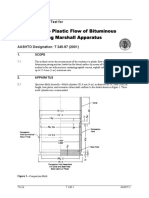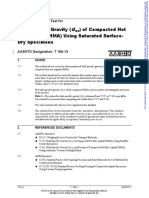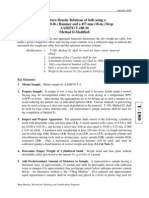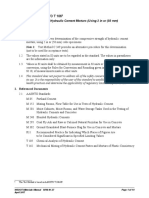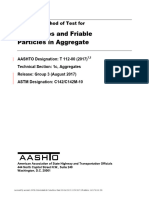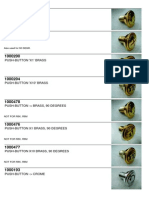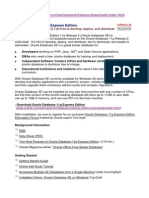Aashto T112
Aashto T112
Uploaded by
Yudith Bdoel AbdullahCopyright:
Available Formats
Aashto T112
Aashto T112
Uploaded by
Yudith Bdoel AbdullahOriginal Description:
Original Title
Copyright
Available Formats
Share this document
Did you find this document useful?
Is this content inappropriate?
Copyright:
Available Formats
Aashto T112
Aashto T112
Uploaded by
Yudith Bdoel AbdullahCopyright:
Available Formats
CLAY LUMPS AND FRIABLE PARTICLES IN AGGREGATE AASHTO T 112
SCOPE To ensure the aggregate used performs as intended for highway construction, several tests are performed to determine the physical characteristics of the material. One of these tests is the determination of Clay Lumps and Friable Particles in Aggregate. Excessive clay lumps in a processed aggregate intended for use in a Portland Cement or Hot Mix Asphalt may interfere with the bonding between the aggregate and cementitious material. This will result in spalling, raveling, or stripping and create weak points and pop-outs if the material is incorporated into the pavement or structure. Aggregate intended to perform as a drainable base or subbase may also be adversely affected when excess amounts of clay and friable particles are present. This type of material tends to fill the void spaces intended for drainability, eventually contributing to pavement failure. Attaining a reasonably accurate determination of the amount of clay lumps and friable particles in the processed aggregate is dependent on properly obtained representative samples. SUMMARY OF TEST There are two test methods for determining the clay lumps and friable particles in aggregates. There is a method for coarse aggregate and one for fine aggregate. The test methods are similar, but there are differences, so always be sure to follow the correct method for the type of aggregate being tested. The material is sampled, dried, and soaked according to testing instructions. The clay lumps and friable particles are broken down by manipulation, using the thumb and forefinger. The material is washed, dried, and sieved according to the correct test procedure. The materials are weighed and the calculations for the percent of clay lumps and friable particles are performed. FINE AGGREGATE Apparatus Balance, sufficient capacity to determine the weight of the test samples, accurate to 0.1 percent of the weight of the sample to be tested, and conforms to the requirements of AASHTO M 231.
Containers, rust-resistant of a size and shape that will permit the spreading of the sample on the bottom in a thin layer. Sieves, conforming to AASHTO M 92. Oven, capable of providing free circulation of air and of maintaining a temperature of 230 9F (110 5C). Sample Preparation First subject the test sample to AASHTO T 11, Amount of Material Finer Than the No. 200 (75 m) Sieve in Aggregate. The sample shall be dried to a constant dry weight at a temperature of 230 9F (110 5C). Remove the material smaller than No. 16 (1.18 mm) sieve by thoroughly sieving the original sample over the No. 16 (1.18 mm) sieve. The weight retained on this sieve is the test sample and must be at least 25 grams. Procedure 1. Weigh the test sample and spread the sample in a thin layer on the bottom of an appropriately sized, rust-resistant container, cover the sample with distilled water and allow the sample to soak for a period of 24 4 hours. Decant the excess water from the sample after soaking. Roll and squeeze individual particles between the thumb and forefinger to attempt to break the particle into smaller pieces. Do not us fingernails, nor press the particles against hard surfaces or each other in the attempt to break the particles. After all discernable clay lumps and friable particles have been broken, sieve the sample on a No. 20 (850 m) sieve and then place the sample in a suitable drying pan. Dry the sample to a constant dry weight at a temperate of 230 9F (110 5C). Allow the sample to cool and weigh the sample to the required accuracy specified for the balance in AASHTO M 231.
2.
3.
Calculations Calculate the percent of clay lumps and friable particles in fine aggregate using the following formula: P = M-R x 100 M Where: P = percent of clay lumps and friable particles M = weight of test sample retained on the No. 16 (1.18 mm) sieve R = weight of material retained on the No. 20 (850 m) sieve 2
COARSE AGGREGATES Apparatus The same apparatus is used for the coarse aggregate test method that is used for the fine aggregate test method. Sample Preparation Subject the sample to be tested to AASHTO T 11, Amount of Material Finer Than No. 200 (75 m) Sieve. The aggregate sample shall be dried to a constant weight at a temperature of 230 9F (110 5C). Separate the coarse aggregate sample into individual fractions using the following sieves to obtain the minimum weights as shown in Table 1: Table 1 Sizes of Particles Making Up Test Sample No. 4 to 3/8 in. (4.75 mm to 9.5 mm) 3/8 in. to 3/4 in. (9.5 mm to 19.0 mm) 3/4 in. to 1 1/2 in. (19.0 mm to 37.5 mm Over 1 1/2 in. (37.5 mm) Min. Weight of Individual Test Sample, Grams 1000 2000 3000 5000
Note: To provide the minimum required individual weight as indicated in Table 1, combining the material from more than one test by AASHTO T 11 may be necessaty. If the original grading of the sample has less than 5% of material retained on any of the above individual sizes, do not test that size.
Procedure 1. Weigh each fraction size and spread the individual samples in rust-resistant pans to form a thin layer. Cover the samples with distilled water and soak for 24 4 hours (Figure 1).
Figure 1 Sample Soaking 2. After soaking, decant the excess water from the samples. Roll and squeeze suspect particles between the thumb and forefinger to attempt to break the particles into smaller sizes (Figure 2). Do not use fingernails to break the particles, or press the particles against a hard surface or each other.
Figure 2 Attempting to Break Particles 3. After all recognizable clay lumps and friable particles have been broken, remove the undersized material from each tested fraction by wet-sieving. The wet-sieving is to be accomplished by placing the sample on the appropriate size sieve for the size of the individual fraction (Table 2) and passing water over the sample while manually agitating the sieve, until all undersize material has passed the required sieve. 4
Table 2 Size of Particles Making Up the Sample No. 4 to 3/8 in. (4.75 mm to 9.5 mm) 3/8 in. to 3/4 in. (9.5 mm to 19.0 mm) 3/4 in to 1 1/2 in. (19.0 mm to 37.5 mm) 1 1/2 in. (Over 37.5 mm) Sieve Size for Removing Residue of Clay Lumps and Friable Particles No. 8 (2.36 mm) No. 4 (4.75 mm) No. 4 (4.75 mm) No. 4 (4.75 mm)
The material that can be broken down and removed from the sample by wetsieving is classified as clay lumps and friable particles. 4. Remove the retained particles carefully from the sieve. Dry the sample to a constant dry weight at 230 9F (110 5C), and allow the material to cool. Weigh the record the weight of the material to the accuracy specified for the balance in AASHTO M 231. Note: Combined aggregates (those containing a substantial amount of coarse and fine material) are separated into two fractions using the No. 4 (4.75 mm) sieve and then prepared as appropriate for the correct size of the material (i.e., coarse or fine aggregate). In most cases, only the plus No. 4 (4.75 mm) fraction of coarse aggregate is required to be evaluated by this test method regardless of the amount of minus No. 4 (4.75 mm) material present. However, the amount of material between the No. 16 (1.18 mm) and No. 4 (4.75 mm) sieves is included in the weight of the test sample when calculating the percent of clay lumps and friable particles.
5.
Calculations Calculate the percent of clay lumps and friable particles in the individual sizes as follows: P = M-R x 100 M where: P = percent of clay lumps and friable particles M = weight of test sample (this is the weight of each size increment prepared for test) Note: include the weight of the plus No. 16 (1.18 mm) to minus No. 4 (4.75 mm) when needed, if the aggregate contains both coarse and fine particles. R = Weight of particles retained on a designated sieve The percent of clay lumps and friable particles in coarse aggregate is an average based on the percent of clay lumps and friable particles in each sieve size fraction weighed in accordance with the grading of the original sample, or preferably the average grading of the entire lot. When the sample contains less than 5 % of the total material in a given size, based on the original grading of the aggregate sample, the increment is considered to have the same percent of clay lumps and friable particles as the next larger or smaller fraction, whichever is present (see Table 3). Table 3 Particle Size No. 4 to 3/8 in. (4.75 mm to 9.5 mm) 3/8 in. to 3/4 in. (9.5 mm to 19.0 mm) 3/4 in. to 1 1/2 in. (19.0 mm to 37.5 mm) Total Percent in aggregate Original Sample Percent Retained 24 15 4 Percent Clay Lumps and Friable Particles 13 8 8* Weighted Average Percent 3.12 1.20 0.32 4.64
* the percent of material retained on the fraction from 3/4 in. (19.0 mm) to 1 1/2 in. (37.5mm) is less than 5 %, therefore the percent of clay lumps and friable particles found to be in the next smaller size increment (8 %) is used in the weighted average.
You might also like
- Sand Equivalent - ASTM D 2419-14Document10 pagesSand Equivalent - ASTM D 2419-14Siti Nur Ain Binti IsaNo ratings yet
- Standard Specification For Aggregate For Masonry MortarDocument3 pagesStandard Specification For Aggregate For Masonry MortarAlbertto GuardadoNo ratings yet
- T 304Document4 pagesT 304Judy RangelNo ratings yet
- ASTM C131/C131M 14: Standard Test Method For Resistance To Degradation of Small-Size Coarse Aggregate by Abrasion and Impact in The Los Angeles MachineDocument5 pagesASTM C131/C131M 14: Standard Test Method For Resistance To Degradation of Small-Size Coarse Aggregate by Abrasion and Impact in The Los Angeles MachineShaheer Ahmad100% (1)
- D559 D559M-15 Standard Test Methods For Wetting and DryingDocument6 pagesD559 D559M-15 Standard Test Methods For Wetting and DryingFaten Abou ShakraNo ratings yet
- Cutback Asphalt (Rapid-Curing Type) : AashloDocument3 pagesCutback Asphalt (Rapid-Curing Type) : AashloNacer KisyNo ratings yet
- Neo FreudiansDocument13 pagesNeo Freudiansapi-287575009No ratings yet
- Embankment and Base Waqtc AASHTO T 99/T 180 In-Place DensityDocument10 pagesEmbankment and Base Waqtc AASHTO T 99/T 180 In-Place DensityFaiber CardenasNo ratings yet
- Resistance To Plastic Flow of Bituminous Mixtures Using Marshall ApparatusDocument10 pagesResistance To Plastic Flow of Bituminous Mixtures Using Marshall ApparatusRichar DiegoNo ratings yet
- t224 PDFDocument2 pagest224 PDFJulio César ChávezNo ratings yet
- Asphalt Module AASHTO T-269 2003 PDFDocument1 pageAsphalt Module AASHTO T-269 2003 PDFguru nathNo ratings yet
- Aashto T11Document3 pagesAashto T11jimbox88100% (2)
- Bulk Specific Gravity of Compacted Hot Mix Asphalt (HMA) Using Saturated Surface-Dry SpecimensDocument6 pagesBulk Specific Gravity of Compacted Hot Mix Asphalt (HMA) Using Saturated Surface-Dry SpecimensAhmad KhreisatNo ratings yet
- Aashto T 309-15Document3 pagesAashto T 309-15William VasquezNo ratings yet
- D 2041 - 00Document4 pagesD 2041 - 00harisahamedNo ratings yet
- Asphalt ExtractionDocument4 pagesAsphalt ExtractionOsikur RahamanNo ratings yet
- d6931 PDFDocument4 pagesd6931 PDFaimen qayyumNo ratings yet
- Aashto T224Document6 pagesAashto T224Gibran IusNo ratings yet
- ASTM D3625 Effects of Water On Asphalt Coated Aggregate Using Boiling MethodDocument2 pagesASTM D3625 Effects of Water On Asphalt Coated Aggregate Using Boiling MethodRamy HusseinNo ratings yet
- Soundness TestDocument3 pagesSoundness TestYasirNo ratings yet
- Aashto T 267-86 (2018)Document4 pagesAashto T 267-86 (2018)Maricel NgaganNo ratings yet
- Aashto T 166Document10 pagesAashto T 166Chainun Taidamrong100% (1)
- Aashto T19-Bulk Density (Unit Weight)Document7 pagesAashto T19-Bulk Density (Unit Weight)Marc Anthony de Villa100% (2)
- Compressive Strength of Bituminous Mixtures: Standard Test Method ForDocument5 pagesCompressive Strength of Bituminous Mixtures: Standard Test Method Foraastha mehtaNo ratings yet
- Moisture-Density Relations of Soils Using A 4.54-kg (10-lb.) Rammer and A 457-mm (18-In.) Drop AASHTO T-180-10 (Method D-Modified)Document3 pagesMoisture-Density Relations of Soils Using A 4.54-kg (10-lb.) Rammer and A 457-mm (18-In.) Drop AASHTO T-180-10 (Method D-Modified)Muhammad Irfan Khan100% (1)
- Astm D546Document2 pagesAstm D546Mohamed Maamoun T.No ratings yet
- Cutback Asphalt (Rapid-Curing Type) : Standard Specification ForDocument2 pagesCutback Asphalt (Rapid-Curing Type) : Standard Specification Fordong ganNo ratings yet
- Preparation of Asphalt Mixture Specimens Using Marshall ApparatusDocument8 pagesPreparation of Asphalt Mixture Specimens Using Marshall ApparatusAnbuchelvan CNo ratings yet
- T267Document2 pagesT267Victor AguirreNo ratings yet
- R30Document4 pagesR30Juan Carlos MejiaNo ratings yet
- Astm D6648-08Document14 pagesAstm D6648-08ROBERTO MIRANDANo ratings yet
- Soil Worksheets (OSAF22)Document120 pagesSoil Worksheets (OSAF22)Lloyd R. Ponce100% (1)
- Astm-D 5361Document3 pagesAstm-D 5361Ricardo Davila100% (1)
- Plastic Limit Plasticity Indext 090Document5 pagesPlastic Limit Plasticity Indext 090Jayson AbejarNo ratings yet
- Aashto T 224 2012Document6 pagesAashto T 224 2012Jose LuisNo ratings yet
- BS 812-102 - 1989Document12 pagesBS 812-102 - 1989ماقوريNo ratings yet
- Aashto T-11 PDFDocument3 pagesAashto T-11 PDFdadadadNo ratings yet
- Aashto T191-14 (2022)Document8 pagesAashto T191-14 (2022)jaheshfarhadNo ratings yet
- Aashto t191 Density in Place by The Sand Cone Method PDFDocument6 pagesAashto t191 Density in Place by The Sand Cone Method PDFdonyNo ratings yet
- Astm D 6084Document4 pagesAstm D 6084AbelClarosNo ratings yet
- Asphalt Ignition Test D6307Document5 pagesAsphalt Ignition Test D6307Anonymous oF1IiGAfNo ratings yet
- WSDOT FOP For AASHTO T 106Document14 pagesWSDOT FOP For AASHTO T 106malaya tripathyNo ratings yet
- Preparation of Bituminous Mixture Test Specimens by Means of California Kneading CompactorDocument4 pagesPreparation of Bituminous Mixture Test Specimens by Means of California Kneading CompactorMax100% (1)
- Astm Ac20Document3 pagesAstm Ac20Juan QuiñonesNo ratings yet
- Astm D 1073Document2 pagesAstm D 1073Konul SeyidovaNo ratings yet
- ASTM D5581 Resistance To Plastic Flow of Bituminous Mixtures Using MarshallDocument5 pagesASTM D5581 Resistance To Plastic Flow of Bituminous Mixtures Using MarshallVijayakrishna SingamsettiNo ratings yet
- D 2974 - 00 PDFDocument4 pagesD 2974 - 00 PDFashrafNo ratings yet
- Astm C131Document2 pagesAstm C131Salahuddin Al-Habal75% (4)
- Department of Civil Engineering: Transportation Engineering-II Lab CIEN-4202Document47 pagesDepartment of Civil Engineering: Transportation Engineering-II Lab CIEN-4202Adnan AhmadNo ratings yet
- Bitumen ExtractionDocument7 pagesBitumen ExtractionArjun Raj100% (2)
- Marshall Correction FactorDocument14 pagesMarshall Correction FactorPedjaNo ratings yet
- Sand Equivalent Value of Soils and Fine Aggregate: Standard Test Method ForDocument10 pagesSand Equivalent Value of Soils and Fine Aggregate: Standard Test Method ForManuel Enrique Vásquez0% (1)
- Astm d1856Document3 pagesAstm d1856Jose AruquipaNo ratings yet
- Aashto T265-15Document4 pagesAashto T265-15Besha aliNo ratings yet
- Standard Astm D 2172 DETERMINATION OF BINDER CONTENT FOR ASPHALT MIXDocument3 pagesStandard Astm D 2172 DETERMINATION OF BINDER CONTENT FOR ASPHALT MIXSAQAR ALGHAMDINo ratings yet
- M 140-08 (Emilsified Asphalt)Document1 pageM 140-08 (Emilsified Asphalt)tran_lamNo ratings yet
- 423339538-T112-0-1 المواد الضارةDocument5 pages423339538-T112-0-1 المواد الضارةyasirNo ratings yet
- QC Tests For Road Works by Bhavanna Rao DVDocument24 pagesQC Tests For Road Works by Bhavanna Rao DVmilind_0786No ratings yet
- Sieve Analysis of Fine and Coarse Aggregates: Test Procedure ForDocument9 pagesSieve Analysis of Fine and Coarse Aggregates: Test Procedure ForMuhammad AfrasiyabNo ratings yet
- Standard Test Procedures Manual: 1. Scope 1.1. Description of TestDocument4 pagesStandard Test Procedures Manual: 1. Scope 1.1. Description of TestTemur LomidzeNo ratings yet
- Sieve AnalysisDocument10 pagesSieve AnalysisBinod MaharajanNo ratings yet
- Junaid CV Done 1 2Document2 pagesJunaid CV Done 1 2Irtiza NaqviNo ratings yet
- Design and Realization of 74 Hamming Code ChannelDocument9 pagesDesign and Realization of 74 Hamming Code Channelbảo thếNo ratings yet
- Arranged Marriage Research Paper ConclusionDocument8 pagesArranged Marriage Research Paper Conclusionaflbuagdw100% (1)
- Generation of PWMDocument2 pagesGeneration of PWMAnna Maria BanicaNo ratings yet
- Professional EducationDocument8 pagesProfessional EducationCa lilNo ratings yet
- Tutorial Creating Parametric Families in Revit MEP 2011Document39 pagesTutorial Creating Parametric Families in Revit MEP 2011rglcosta100% (1)
- CH 12 Study GuideDocument8 pagesCH 12 Study GuideyawahabNo ratings yet
- Eyeglass GuideDocument3 pagesEyeglass Guidehimanshuj75No ratings yet
- Pauls Online Notes - Calculus I - Business ApplicationsDocument7 pagesPauls Online Notes - Calculus I - Business Applicationsnmmng2011No ratings yet
- Georgia Power BillDocument2 pagesGeorgia Power BillcorporationatifNo ratings yet
- CM Tle 9 QTR 2 M. Yna JessicaDocument9 pagesCM Tle 9 QTR 2 M. Yna JessicaJessica PataniNo ratings yet
- Noise Modeling and Analysis of An IMU-based AttituDocument11 pagesNoise Modeling and Analysis of An IMU-based Attituminhal shafiqNo ratings yet
- Understanding The TV Ratings and Parental ControlsDocument7 pagesUnderstanding The TV Ratings and Parental ControlsSat2912No ratings yet
- Gardening and Planting by The M - Nick KollerstromDocument143 pagesGardening and Planting by The M - Nick KollerstromXHIXO OOMONAE100% (1)
- Alfastreet Spare Parts 2009 Colour Low ResolutionDocument35 pagesAlfastreet Spare Parts 2009 Colour Low ResolutionFreder Angel100% (1)
- CV Humberto Villanueva T EngDocument1 pageCV Humberto Villanueva T EngarnoldbcoNo ratings yet
- Wharton SOP.Document2 pagesWharton SOP.siddhathanoop05No ratings yet
- Low-Crosstalk Operation of Si-Wire Cascaded-MZI SwitchDocument3 pagesLow-Crosstalk Operation of Si-Wire Cascaded-MZI SwitchJorge GuerreroNo ratings yet
- Inversor Trifasico Fox 10-500-10052-01-H3AC3-User-ManualDocument44 pagesInversor Trifasico Fox 10-500-10052-01-H3AC3-User-ManualRuben MorenoNo ratings yet
- RCMODocument115 pagesRCMOCesar100% (2)
- Fire Hose Cabinet We ReviewedDocument7 pagesFire Hose Cabinet We Reviewedglenn umaliNo ratings yet
- Animal FarmDocument19 pagesAnimal FarmKerisa GiffordNo ratings yet
- Drum Buffer - Rope MethodDocument65 pagesDrum Buffer - Rope MethodAmit AsthanaNo ratings yet
- Amm 787 543Document7 pagesAmm 787 543loganathan T GNo ratings yet
- CAT 2013 Syllabus of Quantitative AbilityDocument4 pagesCAT 2013 Syllabus of Quantitative AbilityKarthik ChockkalingamNo ratings yet
- 01.DLC Mix Design CementDocument7 pages01.DLC Mix Design CementVijay KashyapNo ratings yet
- Oracle Database 11g Express EditionDocument2 pagesOracle Database 11g Express EditionDinesh Sanagavarapu100% (1)
- Marvel Battleworld League Season OneDocument30 pagesMarvel Battleworld League Season OneJoemNo ratings yet
- Governance Issues and ChallengesDocument4 pagesGovernance Issues and ChallengesMarsha TripathiNo ratings yet
